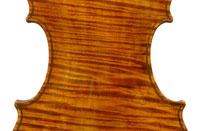|
Ref : 0810
A fine Italian-American violin by
|

go to Home Page see more Violins |
This is an exceptionally beautiful instrument, superbly made from a spectacular choice of materials. Its visual appeal is truly magnificent and the impression is that in making this violin, Galea decided to make something truly unusual.The German researcher Lütgendorff notes that Galea made his first violin at the age of 11 and by age 15 had completed 15 violins. His teacher at that time was the Italian maker, Ami care Coschiera. Galea was eventually accredited as Master Violin Maker by the Italian National Association of Violin Makers in Rome, an accomplishment merited by the high quality of his work.
After the Second World War Galea moved to Durban in South Africa for a position as first violinist in the Durban Symphony Orchestra. At that time Durban was home to Amon Bilmark (1894-1961) - a former pupil of Simone Sacconi. Soon after his arrival in Durban in about 1946, Galea entered a partnership with Bilmark, but that lasted briefly - until 1950. He would remain in South Africa for a total of about 16 years, alternating between Durban and Cape Town. By the late 50s he was established as a violinmaker of a very high order, making instruments for top professional players in South Africa and elsewhere.
During one of his concert tours in South Africa, Yehudi Menuhin met Galea. Menuhin was impressed by Galea's work and suggested that he should move to the United States. Menuhin eventually assisted him in emigrating to the US in 1962. Galea settled in Longbeach Ca. where he opened a violinmaking studio. This studio was soon to dominate the violin community in that area and became noted for excellent repairs and restorations. His renown spread and in 1970 Ruggiero Ricci commissioned a violin from him. For the next 32 years in the USA, Galea enjoyed the recognition he deserved and desired. He remained there for the rest of his life until his death on 28 July 1994, aged 84.
By 1979 Galea had made around 200 instruments and his life's work amounted to around 240 instruments. He made only two to four violins per year, and they are in the hands of professionals all over the world. Being a superb violinist, Galea knew what violinists wanted and never sold an instrument until it conformed to the tonal properties he expected and became known for.
By the time he made this violin, Galea had been living in the USA for around 9 years and was settled and respected as maker and restorer. Galea almost always followed the Stradivari model, but in this 1971 violin he diverts from that pattern and uses the Guarneri model. The resultant tonal properties are consequently somewhat darker. Workmanship is impeccable throughout with great attention to detail.
This violin was discovered near Cape Town in a state of great neglect - another victim of a botched repair by an amateur restorer (of which there are too many!). It has subsequently undergone a full and superb restoration lasting months, which succeeded in rendering the violin back to the magnificent state it was in when it left Galea's hands. All this work was done by Kevin Dunbar - a German-trained restorer.
This violin as a big tone, beautifully clear in the high register and dark in the bottom end.
 |
 |
 |
||
 |
Dimensions : Length of back: 35.7 cm
Based on the Guarneri pattern
Condition : Fully refurbished. New pegs, fingerboard and top saddle. Pegholes are rebushed. One crack in the top is repaired and cleated and virtually invisible. Damage to the original varnish has been corrected and restored. All restoration undertaken by Kevin Dunbar.
Setup by Johan Grobbelaar
Provenance : Owned by Johan Grobbelaar. Earlier provenance withheld.
Found in an obscure environment near Cape Town in a condition of neglect and disuse. An earlier botched effort at repairing by an untrained amateur (- too many of them around!) had left the instrument in a highly compromised state. A 6-month restoration was undertaken by Kevin Dunbar, which has returned the violin to its former superb condition.
Price : P.O.A.
 |
 |
 |
 |
 |
 |
 |
 |
 |
 |
 |
 |
|||||
 |
 |
 |
 |